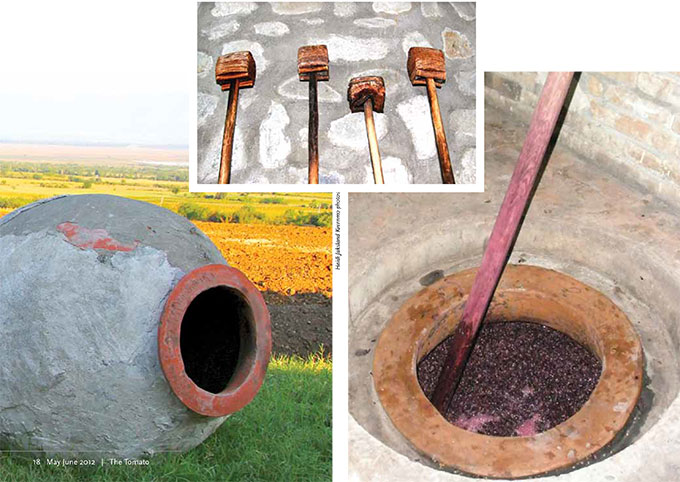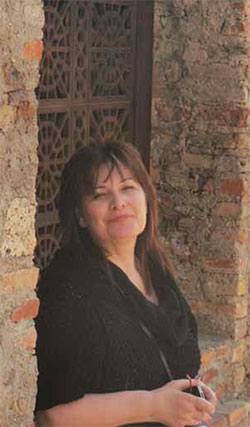by Mary Bailey

No, not that Georgia. The other Georgia, the one that used to be part of the Soviet Union. That Georgia. That’s pretty much the conversation when people ask you about your trip to Georgia.
No peaches, no peanuts, just wine.
This smallish country is tucked in between the Black Sea, Azerbaijan, Armenia and Turkey on the south, with Russia to the north and east. It’s now the democratic republic of Georgia, back to being its own country after 70 years of Soviet domination. Wine is an integral part of the modern reinvention of this ancient nation.
Last September, the Quevri Wine Symposium was held at the Alaverdi monastery in Kakheti, a premium wine-growing region in eastern Georgia in sight of the mysterious and romantic Caucasus Mountains.

The monks, led by Bishop Davit, are no strangers to wine, having made it since 1011. They use quevri, the traditional large clay vessels which are lined in beeswax, sunk into the ground, then filled with grapes. The symposium, attended by scientists, ethnologists, politicians, wine importers, retailers, buyers and writers, was a total immersion — we were baptized in Georgian wine.
The history of making wine in quevri is at least 8000 years old based on clay fragments and wine pips (seeds) found at archeological digs. Over 400 grape varieties have been identified and are grown at Georgia’s National Centre for Grape Vine Propagation.
Everybody makes wine at home, grapes come from the country in the fall, and get put in the quevri. Like we have gas barbecues in our backyards, Georgians have quevri. There seems to be a certain set-it-and-forget-it aspect to making wine in quevri: put whole ripe grapes in the vessel, seal it, and come back next spring. Could it really be that simple?
Yes and no. The temperature control quevri provides is fairly straightforward, but everything else is not fully understood. The science behind this miraculous transformation is studied intensively at the Alaverdi monastary — the centre of all things quevri. According to the their technical director and enologist, Teimuraz Glonti, ”Grape bunch skeleton is rich with terpenes, fatty acids, lactose, fragrant spirits and esters which participate in the complicated process of fragrance making; phenol compounds which create a high level of antioxidant compounds.” All of which makes wine made in quevri act and taste differently.

While wine folks in Georgia are keen to tell you that Georgians were the first to make wine — the focus now is on how to translate tradition and their enviable history into an economically viable wine culture. The symposium was a study in how to move forward by going backward — away from modern winemaking techniques such as stainless steel tanks and inoculated wines, and back to clay. It’s a theme being echoed around the world. Wine makers in the Okanagan are experimenting with egg-shaped cement fermenters. Italians such as Gravner and Radikon in the Collio and Cos in Sicily are known for wines made in amphorae. But don’t let a Georgian hear you call a quevri an amphora. You will be corrected.
But, as in many countries where wine is as common as water, such as southern Italy, you’ll taste too much everyday wine in Georgia — generic Rkatsiteli and too simple Saperavi. But the good stuff is here and worth searching out. Some of the most intriguing wines we tasted were made by accomplished home winemakers, and by monks. A Kisi in particular, made at Alaverdi, was stunning in its fragrance, complexity, and expression.
Georgian wines are ready for prime time. There has been extensive work done on developing an appellation system and categorizing grape varieties. Most of the wines exported are correctly made in a straightforward, easy drinking style. But, as we get more familiar with novel flavours and grape varieties we will start to see wines of cru status in our market.
I’ll drink to that.
Wine
Tbilvino
George and Zurab Margvelashvili operate one of Georgia’s largest wine companies, founded in 1962. Their original markets were Soviet, now 95 per cent of their wine is exported to Europe, Asia, North America and the east — including monthly train loads to Kazakhstan. Most of the wines are made in a modern style, but experiments with quevri are ongoing. Tbilvino sources grapes from several appellations including these wines from western Georgia. Several of the wines currently in stock have some sweetness, a trend in California as well.
Tbilvino Tvishi: Medium sweet white from Tsolikouri grapes, enjoy with crème brulee and birthday cake.
Tbilvino Ojaleshi: Medium sweet red from Lechkhumi. Gorgeous aromas of roses, black cherries, and barberry bush.
Tbilvino Khvanchkara: (70 per cent Aleksandrouli, 30 per cent Mujuretuli) medium sweet red tasting of fresh cherries and raspberries. Excellent with fruit cake, nuts and cheeses.
pheasant’s tears
John Wurdeman, an American expat living in Sighnaghi, is an energetic proponent of quevri wines. Winemaker Gela Patalishvili’s family has made wine in the region for generations. All Pheasant’s Tear’s wines are fermented and aged in quevri. The vineyards grow on the slopes of the Alazani Valley in sight of the Caucasus.
Pheasant’s Tears Rkatsiteli: A light amber coloured wine with aromas of honey and white flowers, medium-bodied and dry with notes of nuts and tree fruit. Enjoy with walnuts.
Pheasant’s Tears Saperavi: The black wine of Georgia. This Saperavi is earthy, somewhat rustic, with rich flavours of black current and nutty undertones. Saperavi can take on grilled meats, ribs, anything off the grill.
coming soon
Château Mukhrani is a spectacular estate first imagined by the Bordeaux-influenced Ivane Mukhranbatoni. The vineyards and house were partially destroyed during the Bolshevik Revolution and were abandoned for several decades. The estate is being carefully rebuilt, with hotel, riding academy, spa and state of the art winery.
There are several small wineries to keep an eye out for. One in particular is Jakeli Organic Vineyard and Wines, a member of the nascent Quevri Wine Association — delicious compelling wines.